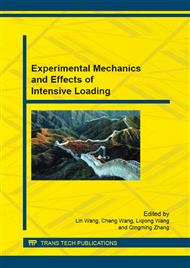[1]
M.F. A'Hearn, M.J. Belton, W.A. Delamere et al. Deep Impact: Excavating Comet Tempel 1[J]. Science, 2005(310): 258-264.
Google Scholar
[2]
C.M. lisse, J. VanCleve, A.C. Adams et al. Spitzer Spectral Observations of the Deep Impact Ejecta[J]. Science, 2006(313): 635-640.
Google Scholar
[3]
M.F. A'Hearn, M.J. Belton, W.A. Delamere et al. Deep Impact: a large-scale active experiment on a cometary nucleus [J]. Space Science Reviews, 2005, 117(1-2): 1-21.
DOI: 10.1007/s11214-005-3387-3
Google Scholar
[4]
W.H. Blume. Deep Impact mission design [J]. Space Science Reviews, 2005, 117(1-2): 23-42.
Google Scholar
[5]
K.J. Meech, N. Ageorges, M.F. A'Hearn et al. Deep Impact: Observation from a worldwide earth-based campaign [J]. Science, 2005, 310(5746): 265-269.
Google Scholar
[6]
C.M. Ernst, P.H. Schultz. Evolution of the Deep Impact flash Implications for the nucleus surface based on laboratory experiments [J]. Icarus, 2007, 190(2): 334-344.
DOI: 10.1016/j.icarus.2007.03.030
Google Scholar
[7]
R.J. Lawrence, W.D. Reinhart, L.C. Chhabildas et al. Spectral measurements of hypervelocity impact flash[J]. International Journal of Impact Engineering, 2006(33): 353-363.
DOI: 10.1016/j.ijimpeng.2006.09.010
Google Scholar
[8]
R.J. Lawrence, W.D. Reinhart, L.C. Chhabildas et al. Hypervelocity Impact Flash at 6, 11, and 25km/s[J].
Google Scholar
[9]
R.W. MacCormack. Investigation of impact flash at low ambient pressures [R]. by NASA.
Google Scholar
[10]
P. Dugger, R. Hendrix. Measurements of transient hypervelocity impact phenomena at the AEDC [J]. AIAA, 1994(1): 10-13.
DOI: 10.2514/6.1994-87
Google Scholar
[11]
J.K. Baird, G.R. Hough, T.R. king. Velocity Dependence of Impact Fluorescence [J]. Impact Engng, 1997, 19(2): 273-276.
DOI: 10.1016/s0734-743x(96)00039-5
Google Scholar
[12]
B. Jean, T.L. Rollins. Radiation from Hypervelocity Impact Generated Plasma [J]. AIAA, 1970, 8(10): 1742–1748.
DOI: 10.2514/3.5984
Google Scholar
[13]
P.E. Nebolsine, A.H. Gelb, R.H. Krech. Impact flash measurements and color temperature determination versus impact velocity [C]. Huntsville: AIAA Space Programs and Technologies Conference, 1996: 4293.
DOI: 10.2514/6.1996-4293
Google Scholar
[14]
G. Eichhorn. Analysis of the hypervelocity impact process from impact flash measurements. Planet Space Science, 1976(24): 771–781.
DOI: 10.1016/0032-0633(76)90114-8
Google Scholar
[15]
M.J. Burchell, M.J. Cole, P.R. Ratcliff. Light Flash and Ionization from Hypervelocity Impacts on Ice [J]. Icarus, 1996, (122): 359-365.
DOI: 10.1006/icar.1996.0129
Google Scholar
[16]
F.D. Rosen, C.N. Scully. Impact flash investigation to 15. 4 km/sec [C]. Tampa, Florida: 7th Symposium on Hypervelocity Impact, (1965).
Google Scholar
[17]
J.W. Gehring, R.L. Warnica. An investigation of the phenomena of impact flash and its potential use as a hit detection and target discrimination technique [C]. Cleveland Ohioan: 6th Symposium on Hypervelocity Impact, (1963).
Google Scholar
[18]
A.A. J ames. Orbital Debris Characterization with Impact Flash Signatures [C]. Huntsville: AIAA Space Programs and Technologies Conference, 1992: 24-27.
DOI: 10.2514/6.1992-1641
Google Scholar
[19]
C.M. Ernst, P.H. Schultz. Effect of velocity and angle on light intensity generated by hypervelocity impacts [J]. Lunar Planetary Science, 2002, 33(1782).
Google Scholar
[20]
W.F. Luo, X.X. Zhao, Q.B. Sun et al. Characteristics of the aluminum alloy plasma produced by a 1064 nm Nd: YAG laser with different irradiances [J]. Indian Academy of Sciences, 2010, 74(6): 945-959.
DOI: 10.1007/s12043-010-0086-8
Google Scholar


